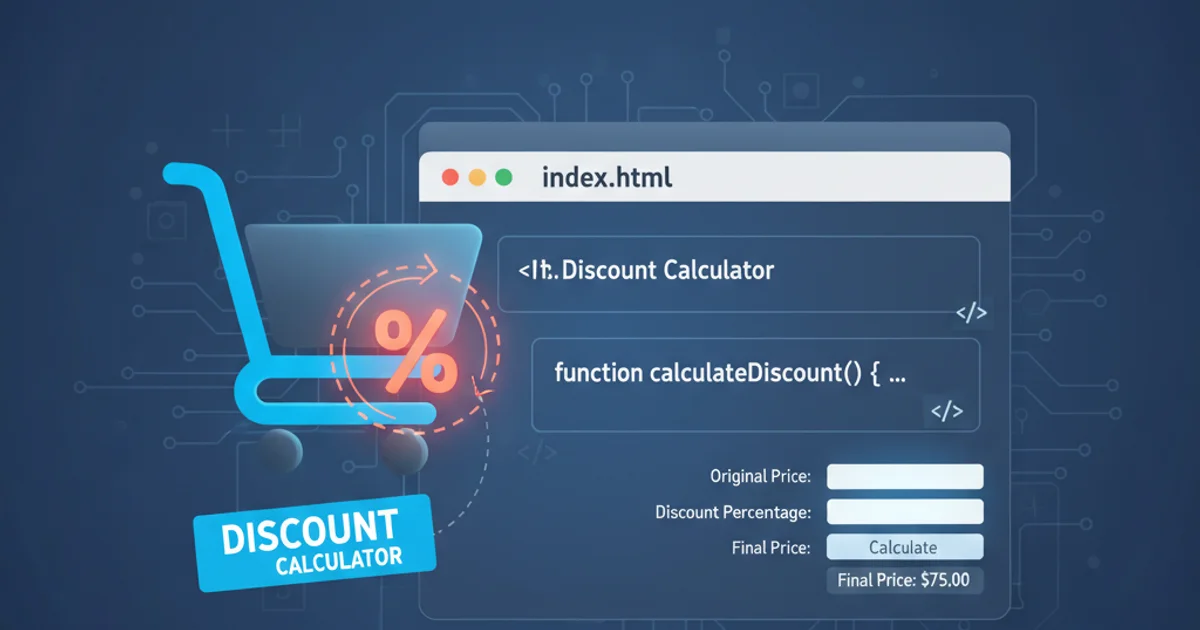Discount Calculator using HTML and javascript
Categories:
Build a Dynamic Discount Calculator with HTML and JavaScript

Learn how to create an interactive web-based discount calculator using basic HTML for structure and JavaScript for dynamic calculations and user interaction.
Creating a discount calculator is a common and practical web development exercise that demonstrates fundamental concepts of HTML for structuring content and JavaScript for handling user input and performing calculations. This article will guide you through building a simple yet effective discount calculator that allows users to input an original price and a discount percentage, then instantly see the discounted price and the amount saved.
Understanding the Core Logic
At its heart, a discount calculator performs two main operations: calculating the discount amount and then subtracting that from the original price to get the final price. The formulas are straightforward:
- Discount Amount:
Original Price * (Discount Percentage / 100) - Final Price:
Original Price - Discount Amount
We'll implement this logic using JavaScript, triggered by user input or a button click. The HTML will provide the input fields and display areas for the results.
flowchart TD
A[Start] --> B["User Inputs: Original Price, Discount %"]
B --> C{"Is input valid?"}
C -->|No| D[Display Error Message]
C -->|Yes| E["Calculate Discount Amount = Price * (Discount / 100)"]
E --> F["Calculate Final Price = Price - Discount Amount"]
F --> G[Display Results: Final Price, Discount Amount]
G --> H[End]Flowchart illustrating the logic for the discount calculator.
Setting Up the HTML Structure
The HTML provides the user interface for our calculator. We'll need input fields for the original price and discount percentage, and elements to display the calculated results. Using semantic HTML elements will make our structure clear and accessible.
<!DOCTYPE html>
<html lang="en">
<head>
<meta charset="UTF-8">
<meta name="viewport" content="width=device-width, initial-scale=1.0">
<title>Discount Calculator</title>
<link rel="stylesheet" href="style.css"> <!-- Optional: for styling -->
</head>
<body>
<div class="calculator-container">
<h1>Discount Calculator</h1>
<div class="input-group">
<label for="originalPrice">Original Price ($):</label>
<input type="number" id="originalPrice" placeholder="e.g., 100" min="0" step="0.01">
</div>
<div class="input-group">
<label for="discountPercentage">Discount (%):</label>
<input type="number" id="discountPercentage" placeholder="e.g., 15" min="0" max="100">
</div>
<button id="calculateBtn">Calculate Discount</button>
<div class="results">
<h2>Results:</h2>
<p>Discount Amount: $<span id="discountAmount">0.00</span></p>
<p>Final Price: $<span id="finalPrice">0.00</span></p>
</div>
</div>
<script src="script.js"></script>
</body>
</html>
type="number", min, max, and step attributes in HTML input fields helps with basic client-side validation and improves user experience by providing appropriate keyboard layouts on mobile devices.Implementing the JavaScript Logic
The JavaScript code will handle reading the input values, performing the calculations, and updating the display. We'll attach an event listener to the calculate button to trigger these actions.
// Get references to HTML elements
const originalPriceInput = document.getElementById('originalPrice');
const discountPercentageInput = document.getElementById('discountPercentage');
const calculateButton = document.getElementById('calculateBtn');
const discountAmountSpan = document.getElementById('discountAmount');
const finalPriceSpan = document.getElementById('finalPrice');
// Function to calculate discount
function calculateDiscount() {
// Get values from input fields
const originalPrice = parseFloat(originalPriceInput.value);
const discountPercentage = parseFloat(discountPercentageInput.value);
// Validate inputs
if (isNaN(originalPrice) || isNaN(discountPercentage) || originalPrice < 0 || discountPercentage < 0 || discountPercentage > 100) {
alert('Please enter valid positive numbers for price and a discount between 0-100%.');
discountAmountSpan.textContent = '0.00';
finalPriceSpan.textContent = '0.00';
return;
}
// Perform calculations
const discountAmount = originalPrice * (discountPercentage / 100);
const finalPrice = originalPrice - discountAmount;
// Display results, formatted to two decimal places
discountAmountSpan.textContent = discountAmount.toFixed(2);
finalPriceSpan.textContent = finalPrice.toFixed(2);
}
// Add event listener to the button
calculateButton.addEventListener('click', calculateDiscount);
// Optional: Add event listeners for 'input' to update results dynamically
originalPriceInput.addEventListener('input', calculateDiscount);
discountPercentageInput.addEventListener('input', calculateDiscount);
parseFloat() function is crucial for converting string input values from HTML fields into numbers that can be used in mathematical calculations. Always validate user input to prevent errors and ensure a robust application.Enhancements and Next Steps
This basic calculator provides a solid foundation. You can enhance it further by:
- Styling: Add CSS to make it visually appealing.
- Error Handling: Implement more sophisticated error messages or visual cues for invalid input.
- Dynamic Updates: As shown in the optional part of the JavaScript, you can make the calculator update results in real-time as the user types, without needing to click a button.
- Multiple Discounts: Extend the functionality to handle multiple discount tiers or coupon codes.
- Accessibility: Ensure proper ARIA attributes and keyboard navigation for users with disabilities.
1. Create HTML File
Save the HTML code provided above as index.html in a new folder.
2. Create JavaScript File
Save the JavaScript code as script.js in the same folder as index.html.
3. Open in Browser
Open index.html in your web browser. You should see the discount calculator interface.
4. Test Functionality
Enter an original price (e.g., 100) and a discount percentage (e.g., 15). Click 'Calculate Discount' or type in the fields to see the results update.